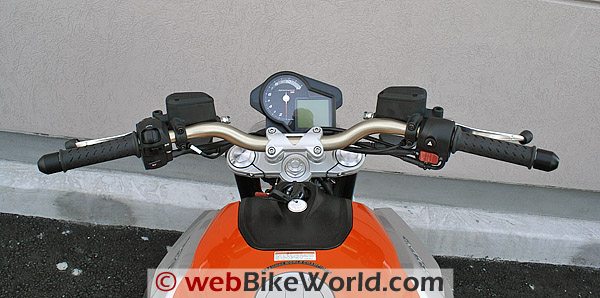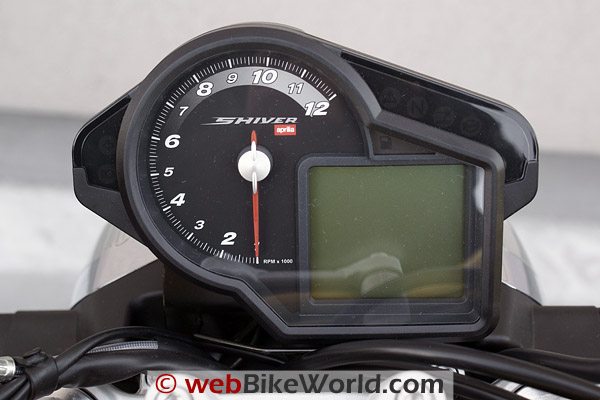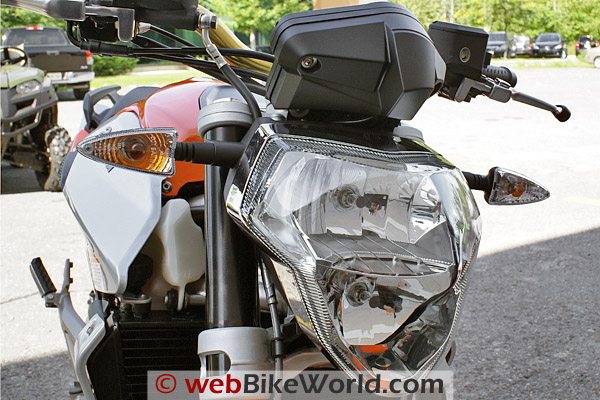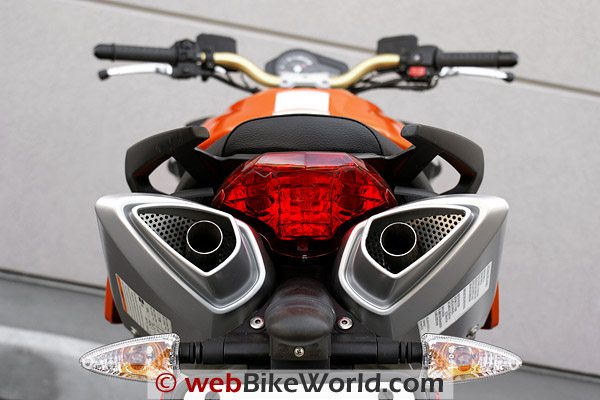2008 Aprilia Shiver SL 750 Ride Report
The Aprilia SL 750 Shiver can be edgy and anxious, strong, or relaxing – the character changes are provided by its three engine mappings.
It is an excellent middleweight choice – light, responsive and day-long comfortable. Despite some component cost-cutting, it rides and runs like the thorough-bred machine it is and Aprilia would not have it any other way.
Although chronologically the Aprilia Shiver (probably) emerged first, at least for the North American market, both the SL 750 Shiver and the Aprilia 850 Mana (ride report) share the same design and, for the most part, the same engineering.
However, while visually similar, mechanically and functionally two discrete and divergent paths are evident. It is this divergence that gives each model its own unique personality and set of capabilities.
As part of the Piaggio conglomerate, Aprilia motorcycles have undergone some major transformations; but one thing not lost is their distinct styling, feeling and performance. The SL 750 Shiver is evidence of that.
Since first seeing the “Fever Silver” and “Code Orange” units sitting on the showroom floor in late March, I have had the chance to use the demo machine on several occasions, including an extended loan period. I liked the Shiver then – and I like it even more now, especially for its multiple personalities…

UPDATE: New 2009 Shiver GT sport-tourer with small fairing to be released at the 2008 Intermot show. ABS will become available as an option on the Shiver and Aprilia Mana.
Overview
Visually attractive, the Shiver and its larger sibling, the Aprilia 850 Mana (review), are hard to ignore, whether in the showroom, parked on the street, or in motion.
Although definitely recognizable as naked sports machines, there is a modern sophisticated look to both of them that exudes class.
Throwing a leg over and settling in, the Shiver fits just fine, even with my 6 ft 3 in frame, 33 in inseam and 34 in reach. The reach to the tapered 31.5 in wide handlebars dictates a very slight pull forward, which I like. Just under 32 inches, the seat height, and distance to the pegs, keeps my legs well positioned.
Like the Kawasaki Versys and the BMW F800 engines, the Shiver V-twin is extremely narrow and compact. Looking down, one only sees the edges of the sculpted tank, the forward side panels that flare out slightly and the foot pegs.
The radiator is quite small and tucked up out of the way, but as with most liquid cooled machines, it would be nice to see a grill guard as a standard fitting. The rubber cooling hoses are visually pretty heavy, but just become part of the trellis tubular frame landscape after a couple of minutes.
While the styling exercise for the 2-into-1-into-2 under seat exhaust system might get mixed marks, as an engineered piece it is very effective. In essence, the large central housing (catalytic converter, etc) is shaped as part of the rear fender and the two triangular-shaped exhausts branch off along each side.
Most riders have been positive over how the exhaust system blends in with the overall design and flow of other major bits and pieces. To my ears, the pipes have a great tone and when the Shiver is in Sports Mode, a sharp edge, akin to a snarl, becomes evident as the engine is pumped up.
The whole design addresses other issues as well – it causes no undue discomfort to rider or passenger from heat and with the guards, allows the use of a set of throw-over saddlebags, large tail-pack or both.

The Control and Information Environment
Controls fall readily to hand – both the clutch and brake levers are fully adjustable with nicely shaped external adjusters.
The mirrors are very simple and flow with the lines of the Shiver. Like all Aprilia and Moto Guzzi models ridden this year the mirrors installed all work extremely well; there is something to be said for simplicity and standardization.
The now familiar immobilizer system is used on the Shiver. The keys are coded for the motorcycle and if none of the keys put in the ignition are verified by the on-board system, the immobilizer prevents the motorcycle from being started.
Unlike some manufacturers that only provide a single key with new machines, two coded keys are provided with the motorcycle. Up to four coded keys can be supported by the system and programmed through the onboard computer.
The right handlebar control housing features a side to side rocker-style engine-shut-off switch for emergency use (left) and for starting (right pressure).
This combination switch also does something very unique: it toggles between the engine mapping modes via the Aprilia electronic engine management system. According to Aprilia, the electronic engine management on the Shiver 750 “features a second generation electronic throttle with Tri-Map selectable triple mapping. Three performance modes, Sport, Touring and Rain, can be selected on the move from a switch on the handlebars.”
This doesn’t mean the rider will have a performance mode ready to select while riding; the desired mode must be selected with the throttle closed “for safety reasons”, according to Aprilia.
According to Aprilia, the Sport mode “provides aggressive instant power”, while the Touring mode “offers smoother throttle action, better suited to relaxed long distance riding” and the Rain mode “provides reduced power for improved safety on slippery surfaces”.
On the left housing is found a fairly large three-way mode control for using and programming the on-board display computer.
The standard turn signal switch functions by left, right, push to cancel actions, while the passing button/Hi-Lo beam switch is located on the forward top edge of the assembly.
Both the analog-sweep tachometer and large LCD share dominance on the instrumentation and information pod. The LCD provides a wide variety of ongoing or selected information: a first-level menu provides access to most standard monitoring functions while a second layer menu allows some very specific information to be programmed via the Mode Control and monitored via the display.
Unlike the 850 Mana, the Shiver fuel cell is located in the ‘traditional’ position, in front of the rider. Although it has a pretty standard competitive style refill port, once closed, the tank is treated as a sealed unit.
Consequently, outside of refueling activities, all gaseous emissions are routed to the Evaporative Emission System canister, mounted in a highly visible spot on the right front of the engine. The system is there for many reasons and should not be tampered with.
Aprilia typically provides good quality suspension components on their models and in general the Shiver does not disappoint.
The rear shock is mounted in a laid-down position, similar to the Kawasaki Versys. But the Sachs shock on the Shiver is better at handling day to day chores than the OEM shock on the Versys.
While the 43mm inverted front fork feels stiff compared to the Mana and even the Tuono, it nevertheless works extremely well, providing good feedback and never getting unsettled, even when pushed over some really rough surfaces.

Shiver Me Timbers
The Shiver is more comfortable than the 850 Mana or the Tuono, a fact proven during two longer rides where extended time in the saddle remained a pleasurable thing and the only stops required were for fuel, food and bio breaks.
Outside of a few missed shifts and a quirky habit of not wanting to go into neutral, the six speed transmission, particularly the first two gears, really allows the Shiver to get up and GO.
At around 3,600 RPM, some indication of what is on tap begins to emerge and by 4,500 to 5,000 RPM, there is no doubt that the tap has been opened – velocity builds very quickly in this region.
But as others have observed, once over 7,500 rpm the Shiver seems to hit a thick blanket and is then mushy up to the 10K redline. The shift indicator lights typically come on at about 6500 rpm, probably a good indicator of the optimum range.
I originally thought that this upper end feel was part of a specific engine mapping mode, but even with some additional kilometres on the machine, and in getting pretty familiar with its performance curve, this characteristic was present in all three modes.

Multiple Personalities Are Good
What really contributes to the fun of riding the Shiver is the ability to bring forth one of three performance personalities at any time – to serve an express purpose or just for the heck of it – via the engine mapping selector.
Of the three modes (selected by the starter button when the engine is turned on and the proper push sequence initiated) the default is Sport.
In this mode, the Shiver likes to romp, stomp and lighten (or loft) its front wheel a lot, all while emitting a real snarl from the exhaust ports. Understandably this was my favourite mode to ride in, especially when traffic thinned out and the twisty tarmac beckoned.
Not needing a phone booth, a quick stop to change into Touring mode brings out the civilized but still powerful side of the engine. The remapped motor is much smoother and the exhaust takes on a mellow tone, and best of all is the excellent mileage observed.
As the rain was (somewhat) dominant during the riding sessions, Rain mode was used quite often, proving very useful. The change from the other two modes is very distinct – power is down and buffered very smoothly through the drive system. For slippery surfaces or for doing the low speed thing around town, this mode works.
Fuel consumption from the 15 litre or 4.0 USG tank averaged just under 40 miles per Imperial gallon (Imperial gallons = 4.55 litres) or about 33 miles per US gallon. The average was calculated over five tanks of 91 and 94 octane fuel.
In Tour mode, the mileage went up to almost 50 per Imperial gallon or 41.5 miles per US gallon, which is a significant increase. Mileage was a bit lower than expected but given the many riding roles it was put through this fact is fully understandable.

Market Specifics
- The black canister and tubing, mounted on the left front of the engine is the California Evaporative Emission System. This is required by the US Environmental Protection Agency (EPA) and California Air Resources Board (CARB).
- The system has a five year or 30,000km warranty (whichever occurs first).
- Accessories – while nothing specific has actually been sighted yet, the Use and Maintenance Book identifies side bags, top box, windshield and mud-flaps as accessories, presumably to be released at a later date. Some pictures of these accessories have been posted on various sites.
Conclusion
Nimble and lightweight, with excellent rider control through the handlebars and riding position, the Shiver is a joy to ride, anywhere, anytime. Being able to change its personality, at the flick of the switch, is fun, satisfying and, somewhat addictive.
While I won’t complain about the machine’s performance, in any mode, I have to wonder just what the machine would be capable of doing if the same 5000 to 6500 rpm push was extended up by two to three thousand rpm. Just thinking of what that could render makes me shiver.
And, I will repeat myself here – I liked the Shiver at first ride, I like it even more now. Competitively priced, especially if marked for end-year clearance, the Shiver goes head to head with some impressive competition in the 600 to 900 cc range and emerges, still standing, as part of the pack.
It is a very attractive package…and I am counting my pennies.
More: Aprilia Shiver Information and Technical Specifications | Aprilia 850 Mana Review | wBW Aprilia Page
|
wBW Ride Report: Aprilia Shiver SL 750
|
|
|---|---|
| Manufacturer: Aprilia | List Price: $9,995.00 (CAD); $8,999.00 (USD) |
| Colors:Fever Silver and Code Orange. | Made In: Italy |
| Comments: Photos by the Author, taken at Gear Head Canada (Ottawa) and in the Calabogie Highlands district of Ontario. Review Date: June-August 2008 Date Published: September 2008 | |
|
Rating Scale is subjective: Unacceptable, Poor, Neutral, Very Good, Excellent, Outstanding.
|
|
Owner Comments and Feedback
See details on submitting comments.
From “D.D.” (9/08): “Regarding your observation of the shift light on the Shiver. On the Tuono the default setting on the shift light is set to coincide with the maximum recommended break in engine RPM. As miles accumulate the activation point of the light can be reset.
Perhaps all Aprilias are the same? I don’t have an owners manual for the Shiver. But it seems a safe bet in light of the low (6500 rpm) activation setting for the indicator you observed.
Love the Site.”
H.B.C.’s Reply: Although I didn’t specifically pursue this point in the article…the optimum performance indicator/shift point is common to virtually all the Aprilia models and I would agree that the usual 6500 rpm point represents the optimum for the Shiver and thus is likely pre-set.
In going thorough some of the other Aprilia model manuals, this feature seems to be programmable, so the comment from D.D. would be absolutely correct. However, I have not yet specifically verified that for the Shiver (but I will). The Mana display has this feature, although the presentation (seems)
to represent optimal range for the different automatic modes.
There are some really good standards and common features being used by the Piaggio Group in general, and Aprilia, Moto Guzzi, etc, specifically…and this approach does not make the respective models any less boring.”



No Comment